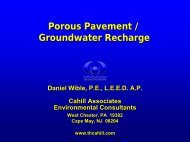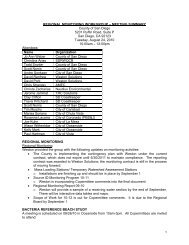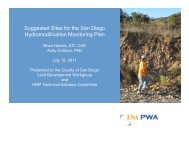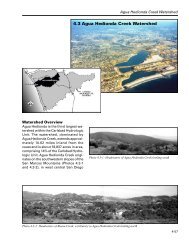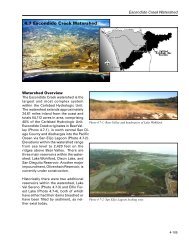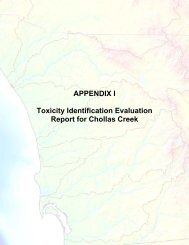APPENDIX I Toxicity Identification Evaluation Reports for Chollas ...
APPENDIX I Toxicity Identification Evaluation Reports for Chollas ...
APPENDIX I Toxicity Identification Evaluation Reports for Chollas ...
Create successful ePaper yourself
Turn your PDF publications into a flip-book with our unique Google optimized e-Paper software.
<strong>Toxicity</strong> <strong>Identification</strong> <strong>Evaluation</strong> of <strong>Chollas</strong> Creek<br />
Stormwater using Hyalella azteca<br />
Discussion<br />
August 2006<br />
5. DISCUSSION<br />
TIE test results provide strong evidence that pyrethroids are the causative agent of toxicity in<br />
the <strong>Chollas</strong> Creek stormwater samples collected during the 2005-2006 monitoring season. In<br />
TIEs per<strong>for</strong>med on samples collected in October, November, January, and February, PBO<br />
treatments led to increased toxicity in the 100% stormwater sample. The repeated potentiation<br />
of toxicity using PBO in all TIEs per<strong>for</strong>med on the 2005-2006 <strong>Chollas</strong> Creek stormwater<br />
samples suggests that pyrethroids may be the causative agents, because PBO is known to<br />
potentiate pyrethroid toxicity (Budavari, 1989). In the TIEs per<strong>for</strong>med on January and February<br />
stormwater samples, a carboxyl esterase test was added to the TIE tests as an additional<br />
method <strong>for</strong> determining whether pyrethroids were the causative agents of toxicity. The carboxyl<br />
esterase enzyme caused a significant reduction in toxicity in the stormwater samples, indicating<br />
that the chemicals causing toxicity in the stormwater sample were enzymatically degraded by<br />
carboxyl esterase. Because carboxyl esterase enzymes have a strong affinity <strong>for</strong> pyrethroids<br />
and are known to metabolize pyrethroids to less toxic <strong>for</strong>ms (Wheelock et al., 2004), these<br />
results support the idea that pyrethroids were the causative agent of toxicity in the <strong>Chollas</strong><br />
Creek stormwater samples.<br />
Additional TIE tests also indicated that the causative agents of toxicity in stormwater had similar<br />
physicochemical properties to those of pyrethroids. Filtration of the stormwater sample<br />
completely reduced the toxicity to H. azteca in the 100% stormwater samples from October and<br />
February and almost completely reduced toxicity in the January stormwater samples, indicating<br />
that the causative agents of toxicity were highly bound to particulates in the stormwater sample.<br />
It is well known that pyrethroids are insoluble in water but soluble in solvents (have high K ow s),<br />
have low vapor pressures (indicating low volatility), and have high adsorption coefficients,<br />
indicating their tendency to adsorb to particulates (Kidd and James, 1991). In the October TIE,<br />
as well as in TIEs per<strong>for</strong>med on <strong>Chollas</strong> Creek stormwater samples in previous years, toxicity of<br />
H. azteca exposed to diluted and undiluted stormwater (80 to 100% survival) was significantly<br />
lower than that in the initial toxicity test (7.5 to 42.5% survival). This indicates that during the<br />
time elapsed between the initial and baseline toxicity tests, the causative agent in the<br />
stormwater sample had degraded, or had significantly adsorbed to the plastic container in which<br />
the sample was held. Moreover, in the specialized test per<strong>for</strong>med on the November <strong>Chollas</strong><br />
Creek stormwater sample, significantly higher toxicity was demonstrated in glass test chambers<br />
relative to plastic test chambers further demonstrating that the causative agent had adsorbed to<br />
the plastic, thus leading to a reduced toxicity to organisms in the plastic test chambers. In<br />
addition, not only did PBO potentiate the toxicity, but there was also higher toxicity in the PBO<br />
treatments using glass containers relative to those treatments in which plastic was used. These<br />
results are not unexpected because in a study by Wheelock et al. (2005), it was demonstrated<br />
that pyrethroids are chemicals that are well-known to adsorb to plastic, thus leading to a<br />
significant time-dependent reduction in toxicity to species including C. dubia and H. azteca.<br />
TIE tests also indicate that the causative agents of toxicity in the <strong>Chollas</strong> Creek stormwater<br />
samples did not share similar physicochemical properties to those of many other classes of<br />
chemicals. The lack of toxicity reduction in the EDTA, STS, graduated pH, and aeration tests in<br />
TIEs per<strong>for</strong>med on the October, January, and February stormwater samples indicates that the<br />
causative agent was likely not a metal, an oxidative chemical, a pH-sensitive chemical, or a<br />
volatile chemical or surfactant, respectively.<br />
In addition to TIE tests, chemical analyses of <strong>Chollas</strong> Creek stormwater samples indicate that<br />
pyrethroids are likely the primary causative agents of toxicity. Pyrethroids including bifenthrin<br />
and permethrin were measured in <strong>Chollas</strong> Creek stormwater samples at levels that exceeded<br />
Weston Solutions, Inc. 28






